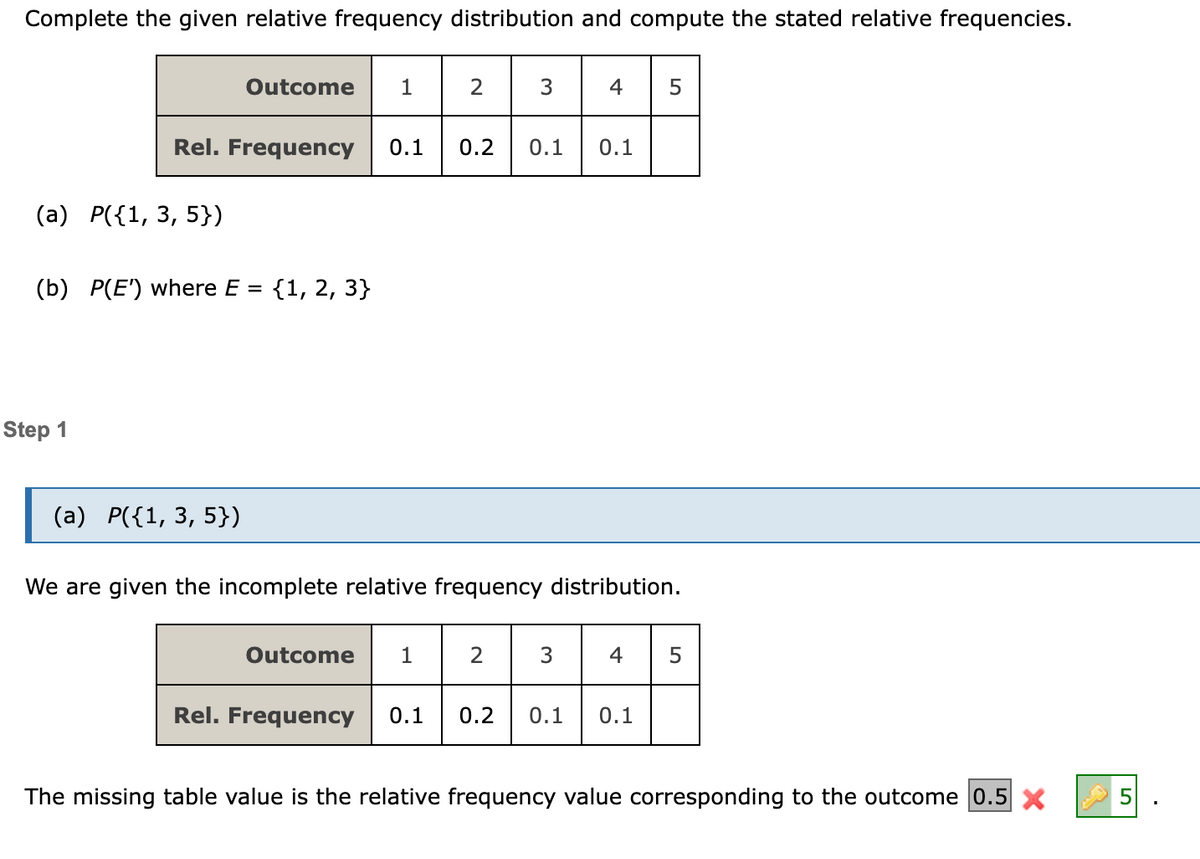Complete the given relative frequency distribution and compute the stated relative frequencies. Outcome 12 3 Rel. Frequency (a) P({1, 3, 5}) (b) P(E') where E = {1, 2, 3} 4 5 0.1 0.2 0.1 0.1
Complete the given relative frequency distribution and compute the stated relative frequencies. Outcome 12 3 Rel. Frequency (a) P({1, 3, 5}) (b) P(E') where E = {1, 2, 3} 4 5 0.1 0.2 0.1 0.1
Glencoe Algebra 1, Student Edition, 9780079039897, 0079039898, 2018
18th Edition
ISBN:9780079039897
Author:Carter
Publisher:Carter
Chapter10: Statistics
Section10.3: Measures Of Spread
Problem 26PFA
Related questions
Question

Transcribed Image Text:Complete the given relative frequency distribution and compute the stated relative frequencies.
(a) P({1, 3, 5})
Step 1
Outcome 1
Rel. Frequency 0.1 0.2
(b) P(E) where E = {1, 2, 3}
(a) P({1, 3, 5})
2
Outcome 1
0.1
2
4
We are given the incomplete relative frequency distribution.
3
0.1
5
4 5
Rel. Frequency 0.1 0.2 0.1 0.1
The missing table value is the relative frequency value corresponding to the outcome 0.5 X
5

Transcribed Image Text:For the incomplete relative frequency distribution, replace the missing relative frequency corresponding to the outcome 5 with an x.
Outcome
1
Rel. Frequency 0.1 0.2
2
P(1) + P(2) + P(3) + P(4) + P(5) = 1
0.1 +
+ 0.1 +0.1 + x = 1
X =
3
0.1
4 5
In order to complete the relative frequency distribution, we need to solve for the unknown x. Recall the property of relative frequency distributions that for a sample space
+ P(Sn) =
= 1. In other words, the relative frequencies across the whole sample space sum to 1. Use this fact to write an equation for x and
‚ s}, we have P(S₁) + P(S₂) +
S = {S₁, S₂,
1'
solve it.
0.1 X
Expert Solution
This question has been solved!
Explore an expertly crafted, step-by-step solution for a thorough understanding of key concepts.
Step by step
Solved in 2 steps

Recommended textbooks for you

Glencoe Algebra 1, Student Edition, 9780079039897…
Algebra
ISBN:
9780079039897
Author:
Carter
Publisher:
McGraw Hill

Glencoe Algebra 1, Student Edition, 9780079039897…
Algebra
ISBN:
9780079039897
Author:
Carter
Publisher:
McGraw Hill